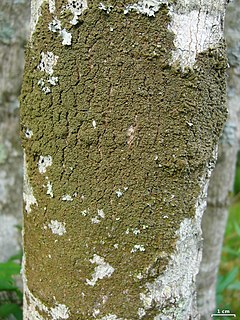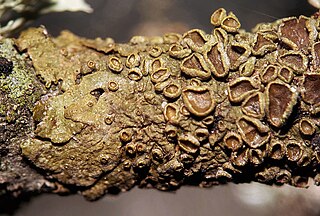
Parmelia is a genus of medium to large foliose lichens. It has a global distribution, extending from the Arctic to the Antarctic continent but concentrated in temperate regions. There are about 40 species in Parmelia. In recent decades, the once large genus Parmelia has been divided into a number of smaller genera according to thallus morphology and phylogenetic relatedness.

Melanelia is a genus of lichenized fungi in the family Parmeliaceae. The genus was circumscribed by Ted Esslinger in 1978.

Melanohalea is a genus of foliose lichens in the family Parmeliaceae. It contains 30 mostly Northern Hemisphere species that grow on bark or on wood. The genus is characterized by the presence of pseudocyphellae, usually on warts or on the tips of isidia, a non-pored epicortex, and a medulla containing depsidones or lacking secondary compounds. Melanohalea was circumscribed in 2004 as a segregate of the morphologically similar genus Melanelia.

Melanelixia is a genus of foliose lichens in the family Parmeliaceae. It contains 15 Northern Hemisphere species that grow on bark or on wood. The genus is characterized by a pored or fenestrate epicortex, and the production of lecanoric acid as the primary chemical constituent of the medulla. Melanelixia was circumscribed in 2004 as a segregate of the related genus Melanelia.
Emodomelanelia is a lichen genus in the family Parmeliaceae. It is monotypic, containing the single foliose Himalayan species Emodomelanelia masonii.
Austromelanelixia is a genus of five species of foliose lichens in the family Parmeliaceae. All species are found in the Southern Hemisphere.
Melanohalea zopheroa is a species of lichen in the family Parmeliaceae. It was first formally described in 1977 by Ted Esslinger as Parmelia zopheroa. A year later, he transferred it to the new genus Melanelia, which he created to contain the brown Parmeliae species. In 2004, after early molecular phylogenetic evidence showed that Melanelia was not monophyletic, Melanohalea was circumscribed by lichenologists Oscar Blanco, Ana Crespo, Pradeep K. Divakar, Esslinger, David L. Hawksworth and H. Thorsten Lumbsch, and M. zopheroa was transferred to it. The lichen has a disjunct distribution, as it is found in South America (Chile) and in New Zealand.
Melanohalea trabeculata is a species of foliose lichen in the family Parmeliaceae. It was first formally described by Finnish lichenologist Teuvo Ahti in 1966 as Parmelia trabeculata. Ted Esslinger transferred the species to the new genus Melanelia in 1978, which he circumscribed to contain the brown parmeliae species. In 2004, it was moved to the newly circumscribed genus Melanohalea.
Melanohalea tahltan is a species of foliose lichen in the family Parmeliaceae. It was described as a new species in 2016. The species named honours the indigenous Tahltan people that live in northern regions of the Canadian province British Columbia.
Melanohalea austroamericana is a species of foliose lichen in the family Parmeliaceae. It was described as a new species in 2016. The lichen is known only from two specimens collected in Chile's Laguna del Laja National Park, where they were discovered growing on bark in a forest of Chilean cedar. The specific epithet austroamericana refers to its South American distribution.
Melanohalea beringiana is a species of foliose lichen in the family Parmeliaceae. It was described as a new species in 2016. The type was collected near the Richardson Highway, north of Paxson, Alaska, where it was found growing on the bark of a trunk of balsam poplar. The specific epithet beringiana refers to its Alaskan distribution. It is morphologically similar to Melanohalea olivaceoides, but is genetically distinct from that species.
Melanohalea clairi is a species of lichen in the family Parmeliaceae. It was described as a new species in 2016. It is known from only two locations in the United States. The type specimen was collected from the White River National Forest in Colorado, in juniper-oak mountainous shrubland. Here it was found growing on Gambel oak. It has also been collected from the Wasatch Front in central Utah, where it was recorded on bigtooth maple. The lichen is morphologically similar to Melanohalea subolivacea, but is genetically distinct from that species.
Melanohalea davidii is a species of foliose lichen in the family Parmeliaceae. It was described as a new species in 2016. The type was collected by Ana Crespo in the Sierra de Grazalema Natural Park in the province of Cádiz, Spain, where it was found growing on cluster pine. In addition to the type locality, it has also been recorded from Selas in the province of Guadalajara. The specific epithet davidii honours lichenologist David Leslie Hawksworth. The lichen is morphologically similar to Melanohalea exasperata, but is genetically distinct from that species.
Melanohalea mexicana is a species of lichen in the family Parmeliaceae. Found in Mexico, it was described as a new species in 2010 by Ted Esslinger and Rosa Emilia Pérez-Pérez. Within the genus Melanohalea, molecular phylogenetic analysis places it in the "subolivacea" group, which includes the species M. subolivacea and M. clairi.
Melanohalea subverruculifera is a species of lichen in the family Parmeliaceae. Found in China, it was first formally described as a new species in 1980 as Parmelia subverruculifera. It was transferred to the segregate genus Melanelia in 1991, and then to the genus Melanohalea in 2004.

Melanohalea subolivacea, commonly known as the brown-eyed camouflage lichen, is a species of foliose lichen in the family Parmeliaceae.

Melanohalea subelegantula is a species of lichen in the family Parmeliaceae. It is found in North America, where it grows on bark and wood. The lichen was first formally described as Parmelia subelegantula by Ted Esslinger in 1977. A year later he transferred it to the segregate genus Melanelia. In 2004, it was moved to the newly circumscribed genus Melanohalea. Named for its resemblance to Melanohalea elegantula, it can be distinguished from that species by its slightly flattened, but not hollow, isidia.

Melanohalea elegantula, commonly known as the elegant camouflage lichen, is a species of lichen in the family Parmeliaceae. It was first described by Alexander Zahlbruckner in 1894 as Parmelia aspidota var. elegantula. Hungarian lichenologist Ödön Szatala promoted it to full species status, as Parmelia elegantula, in 1930. Ted Esslinger transferred it to the genus Melanelia in 1978. Finally, it was assigned to the newly circumscribed genus Melanohalea in 2004.
Pleurosticta koflerae is a species of foliose lichen in the family Parmeliaceae. It is a member of the group of species informally known as the "brown Parmeliae". The lichen was first formally described as Parmelia koflerae by lichenologists Georges Clauzade and Josef Poelt in 1961. Theodore Esslinger transferred it to the genus Melanelia in 1978 when he reorganized the classification of the brown Parmeliae, a continuation of his research on the group published the year before. It was finally transferred to the newly resurrected genus Pleurosticta in 1988 by H. Thorsten Lumbsch and John A. Elix.

Xanthoparmelia loxodes is a species of foliose lichen in the family Parmeliaceae. It was first formally described by Finnish botanist William Nylander in 1872, as Parmelia loxodes. In 1978, Ted Esslinger created the genus Neofuscelia, which contained species previously classified in Parmelia subgenus Neofusca; Neofuscelia loxodes was one of many species transferred here. In a 2004 molecular phylogenetic study published by Oscar Blanco, Ana Crespo, John A. Elix, David L. Hawksworth and H. Thorsten Lumbsch, they showed that Neofuscelia did not form a clade distinct from Xanthoparmelia, and they reduced it to synonymy under Xanthoparmelia.







